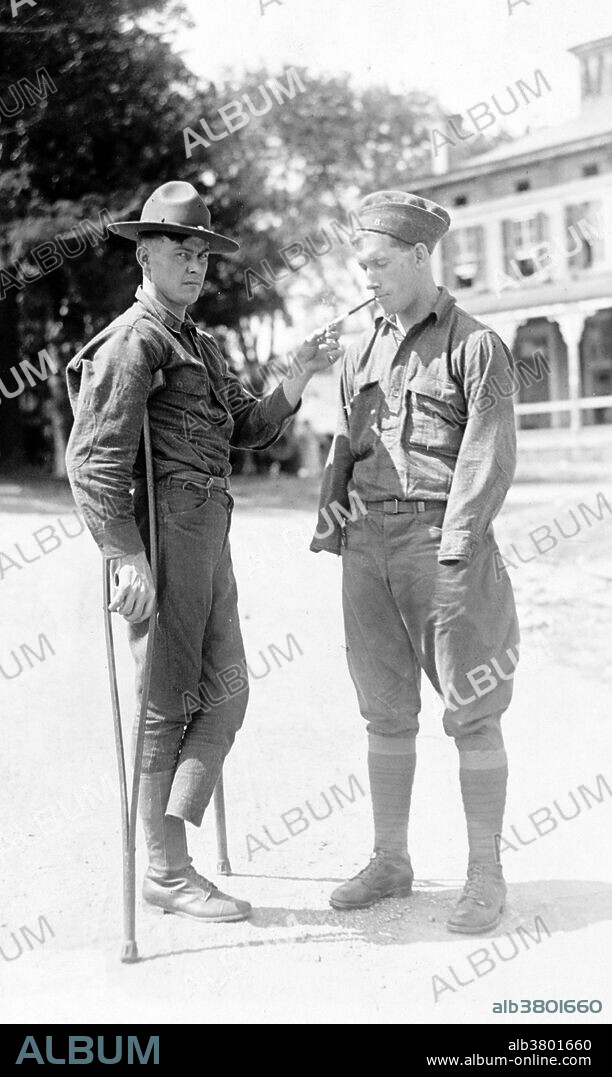alb3801660
WWI, Amputees, Casualties of War

|
Add to another lightbox |
|
Add to another lightbox |



Buy this image.
Select the use:

Title:
WWI, Amputees, Casualties of War
Caption:
At Walter Reed Hospital, a soldier who is missing a foot lights a cigarette for another soldier who is missing both arms. Before WWI the hospital's capacity was 80 patient beds. But during the war it grew to 2,500 in a matter of months. When a soldier was hit by a bullet (soft lead ball) it flattened, causing terrible injuries, shattering bone, and tearing off large chunks of flesh. There were no antibiotics, no way to fight infection except removing a limb before gangrene set in. In traumatic amputations, the limb was simply cut across and the bone trimmed. There was no sanitation and the doctors reused tools without even washing them.
Credit:
Album / LOC/Science Source
Releases:
Model: No - Property: No
Rights questions?
Rights questions?
Image size:
3000 x 5022 px | 43.1 MB
Print size:
25.4 x 42.5 cm | 10.0 x 16.7 in (300 dpi)
Keywords:
1ST WORLD WAR • 20 20TH XX XXTH TWENTIETH CENTURY • 20 XX TWENTIETH CENTURY • 20TH CENTURY • 20TH • AEF • ALLIED FORCES • AMERICAN EXPEDITIONARY FORCES • AMERICAN • AMPUTATE • AMPUTATED • AMPUTEE • ARM AMPUTATION • ARMED FORCES • BW • CASUALTIES • CASUALTY • CELEBRITIES • CELEBRITY • CIGARETTE • DISABILITY • DISABLED • DOGFACE • DOUGHBOY • EVENT • EVENTS • FAMOUS PEOPLE • FAMOUS • FIRST WORLD WAR • FOOT AMPUTATION • FOOT SOLDIER • FOOT-SOLDIER • FOTOGRAFIA • GLOBAL WAR • GREAT WAR • GUERRA • HANDICAP • HANDICAPPED • HISTORIC • HISTORICAL • HISTORY • HUNDRED YEARS WAR • I WORLD WAR • IMPAIRED • IMPORTANT • INFANTRYMAN • INJURED • INJURY • KILLED SOLDIER • LIGHTING • MALE • MAN • MEN • MILITARY HOSPITAL • MILITARY • MOMENT IN TIME • NOTABLE • PHOTO • PHOTOGRAPH • PHOTOGRAPHIE • PHOTOGRAPHY • SMOKE • SMOKING • SOLDIER • TWENTIETH CENTURY • UNITED STATES • US • USA • WALTER REED ARMY MEDICAL CENTER • WALTER REED GENERAL HOSPITAL • WALTER REED HOSPITAL • WAR • WARFARE • WARS • WELL-KNOWN • WORLD WAR 1 • WORLD WAR I (1914-18) • WORLD WAR I • WORLD WAR ONE • WRAMC • WW1 • WWI
 Pinterest
Pinterest Twitter
Twitter Facebook
Facebook Copy link
Copy link Email
Email
